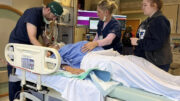Parishioners at St. Stephen and St. Joseph churches in Oil City who were still digesting the news of the proposed closing of St. Stephen were given more information this weekend about the “poor’ physical condition of the St. Stephen building.
Its condition, they were told, demanded expensive and immediate “emergency repair,” and this situation had led to the recommendation that the building be sold or demolished at that the parish merge with St. Joseph by the new year.
Matt Toscano, one of the 10 members of the lay committee that has proposed the St. Stephen closure, told the congregations in a presentation at Masses this weekend that, “all told, St. Stephen requires around $1 million in the short-term, with costs that could soar to $3.1 million over the next 10 years.”
This included reports from Building Systems Inc. that painted a dire picture of the defects in both churches’ structures along with data about the demographic, sacramental and financial vitality of the “Oil City Catholic Community.”
In comparing the situation at the two church buildings, Toscano said repairs at St. Stephen will drain the community’s resources much more quickly than the necessary repairs at St. Joseph.
The immediate repairs at St. Stephen, “combined with our operating deficit will deplete all of our combined reserve funds very quickly,” Toscano said.
In light of this, preserving St. Joseph instead of St. Stephen “will give us time to continue planning so that we can build a sustainable future for our faith in Oil City.”
Toscano told the congregations that “with our costs continuing to rise and our income continuing to decline,” unless something is done, “how will we lay the foundation for the future of our faith in five, 10, 15 or 20 years?”
The report from BSI on the two churches’ evaluations, as well as a copy of Toscano’s remarks, have been posted to the Oil City Catholic Community website.
The proposed closing of the 112-year-old St. Stephen building on State Street has led to some strongly-worded disagreement in some posts on social media, with some people saying St. Joseph should be closed instead of St. Stephen.
Toscano’s presentation, along with the information newly posted on the Catholic Community website, seemed to address concerns raised on Facebook and other outlets.
One claim posted on Facebook said that St. Stephen’s access to $1.2 million in “unrestricted assets in reserve” greatly surpassed St. Joseph’s access to $356,000. Toscano said the $1.2 million would be depleted “very quickly” by the “short-term critical repairs” compelled by the “distressed condition” at St. Stephen.
The current amount of reserved monies includes assets gained by the closing of three other parishes in Oil City and the merger of their assets in 2017 with either St. Stephen or St. Joseph.
And, Toscano said, although “St. Joseph Church is not in perfect condition by any stretch of the imagination” and maintenance costs there “could easily rise as high as $2.5 million over the next 10 years,” St. Joseph didn’t currently require any emergency repairs.
He further emphasized that the Catholic community is operating in the red.
“Let me repeat,” he said, “our income fell more than $100,000 short of our operating expenses in the last fiscal year.”
Highlights of BSI report
Toscano highlighted some of the details of the BSI report, such as, “in the words of Building Systems Incorporated, the exterior face (of St. Stephen) is visibly falling off and severely damaged.”
The BSI report said the situation is of “great concern” because of “pieces falling from the face and potentially injuring pedestrians.”
Earlier reports said that the Rev. John Miller, pastor of the two parishes, had work done in 2018 to “temporarily” stabilize this facade after debris had been found in the parking lot. Protective fencing was also placed along some parts of the sidewalk outside the church, and that fencing is still there.
Toscano said “the critical repairs to the towers and front steps alone are nearly three-quarters of a million dollars.”
He pointed out that BSI also brought to light that “serious questions about the boiler” will needed to be addressed soon.
“This is just the beginning,” said Toscano.
Toscano also clarified that while “there are some large projects that should be completed over the next one to five years to prevent any serious damage (at St. Joseph), the costs over a longer period of time are not as high as the cost of the emergency repairs at St. Stephen that need to be completed immediately.”
The overall budget total that BSI estimates for the completion of building renovations at St. Stephen is $2,763,000, which would include demolition and construction work on the structure, parking lot, windows, doors, roof, flooring, HVAC, plumbing, electricity and code compliance for kitchen and other facilities.
Renovations at St. Joseph for the same categories minus the parking lot, kitchen and exterior front stairs and railing are estimated at $2,255,000.
The difference between the two estimates is $508,000.
– “The concrete on the exterior stairs are deteriorated and unsafe. Railings are rusted. This work should be done ASAP. Most of the steps are barricaded currently because they are not useable.”
– “The water infiltration penetrating through the openings in the facade is most certainly causing damage to the super structure behind which could fail if damaged beyond repair.”
– “The boiler is in poor to non-operable condition and needs replaced immediately” and “there appears to be suspicious pipe wrap on the heating lines that should be addressed immediately.”
Among the repairs at St. Joseph, BSI says the iconic twin towers need some care.
– “The towers should be maintained to ensure a solid structure and the flashings at the towers should be inspected and sealed.” This work should be done “in the next two to three years.”
Other exterior restoration at St. Joseph should be done in the next one to two years, such as patching and tuck-pointing to prevent water damage, especially over the front doors, the report said.
BSI also said that once the exterior restoration was done, the roof at St. Joseph should be replaced in the next one to four years.
Besides the BSI report, a “pastoral planning and quick facts” report was also recently posted on the Catholic Community website.
The summary gave the rather startling statistic that the current rate of Mass attendance at 800 persons per week is projected to drop to 272 in 20 years, or five percent each year.
In light of the statistics, Toscano encouraged the Mass attendees to “review the data on the church website” and to offer feedback “to present an even more sustainable plan for the future than we have developed. I encourage you to ask questions in order to do so. Call the priests. Talk to a committee member. We are all in this together.”
Parishioners who want to sign up for 10-minute listening sessions that will start Monday have been asked to call the parish office.
In addition to Toscano, the other planning committee members are Pastoral Council President Leon Kulinski, Tracy Lander, Matt Gorcezny, Nick Moran, Joan Slater, Amy Kapp, Mike Morrison, McKenzie Healy and Tom Ward.
There are five members from each parish.






































